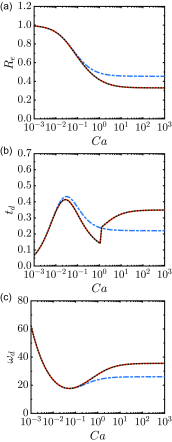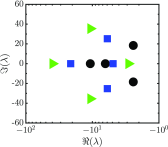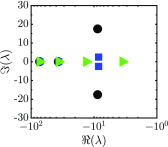The effects of heat and mass diffusion on freely oscillating bubbles in a viscoelastic, tissue-like medium
- PMID: 28253700
- PMCID: PMC6910019
- DOI: 10.1121/1.4976081
The effects of heat and mass diffusion on freely oscillating bubbles in a viscoelastic, tissue-like medium
Abstract
In certain cavitation-based ultrasound techniques, the relative importance of thermally vs mechanically induced damage is unclear. As a first step to investigate this matter, a numerical model for bubble dynamics in tissue-like, viscoelastic media is presented in which full thermal effects are included inside and outside the bubble, as well as interdiffusion of vapor and non-condensible gas inside the bubble. Soft tissue is assumed to behave according to a Kelvin-Voigt model in which viscous and elastic contributions are additive. A neo-Hookean formulation, appropriate for finite-strain elasticity, accounts for the large deformations produced by cavitation. Numerical solutions to problems of relevance to therapeutic ultrasound are examined, and linear analysis is used to explain the underlying mechanisms. The dependence between the surrounding medium's elasticity (shear modulus) and the extent to which the effects of heat and mass transfer influence bubble dynamics is quantified. In particular, the oscillation properties are related to the eigenvalues determined from linear theory. Regimes under which a polytropic relation describes the heat transfer to sufficient accuracy are identified, for which the complexity and computational expense associated with solving full partial differential equations can be avoided.
Figures












References
-
- Brennen C. E., Cavitation and Bubble Dynamics ( Oxford University Press, Oxford, 1977), pp. 1–294.
-
- Franc J. P. and Michel J. M., Fundamentals of Cavitation ( Kluwer Academic, Dordrecht, 2004), pp. 1–306.
-
- Leighton T. G., “ Bubble population phenomena in acoustic cavitation,” Ultrason. Sonochem. 2, S123–S136 (1995).10.1016/1350-4177(95)00021-W - DOI
-
- Coussios C. C. and Roy R. A., “ Applications of acoustics and cavitation to noninvasive therapy and drug delivery,” Annu. Rev. Fluid Mech. 40, 395–420 (2008).10.1146/annurev.fluid.40.111406.102116 - DOI
Publication types
MeSH terms
Grants and funding
LinkOut - more resources
Full Text Sources
Other Literature Sources
Research Materials

